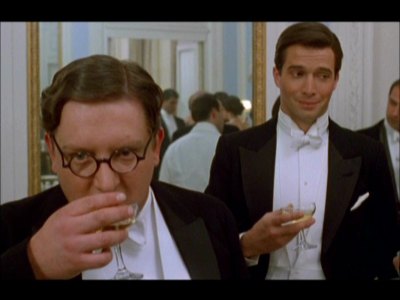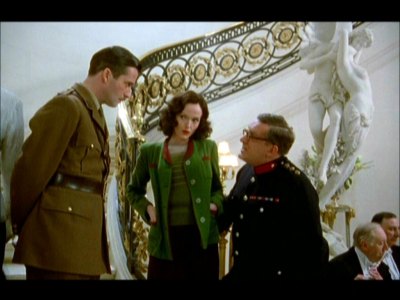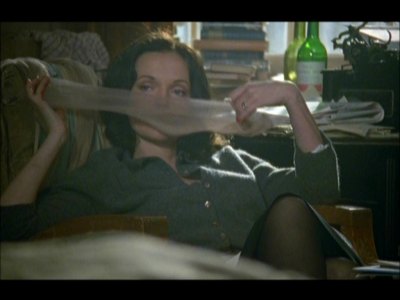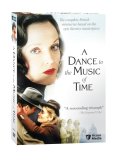| Reviews & Columns |
|
Reviews DVD TV on DVD Blu-ray 4K UHD International DVDs In Theaters Reviews by Studio Video Games Features Collector Series DVDs Easter Egg Database Interviews DVD Talk Radio Feature Articles Columns Anime Talk DVD Savant Horror DVDs The M.O.D. Squad Art House HD Talk Silent DVD
|
DVD Talk Forum |
|
|
| Resources |
|
DVD Price Search Customer Service #'s RCE Info Links |
|
Columns
|
|
|
Dance to the Music of Time, A
I would imagine most lovers of English literature have Anthony Powell's 12-novel, decades-in-the-making (1951 to 1975) cycle of novels, often referred to collectively as A Dance to the Music of Time, on their wish lists of important novels to read - if they ever manage to have enough time to properly devote to them. I tried to fit them in one summer, years ago, but I only lasted through At Lady Molly's, the fourth novel in the cycle (distracted by James Jones' massive Some Came Running, if I remember correctly).

What I did read was quite brilliant, with Powell's serio-comic, sideways glances at British culture and society playing marvelously among the sometimes snotty, snobby - yet curiously chilly and impassive - tone. Long thought impossible to adapt to film or television, Britain's Channel 4 produced a costly 7-hour miniseries, entitled A Dance to the Music of Time, back in 1997. It's a curious film, filled with individual scenes that work well, but when gathered together, fail to jell into anything of substantial weight. The meandering atmosphere is further exacerbated by the filmmakers' disastrous decision to cast multiple actors for the same roles, causing confusion for the viewer, and ultimately distancing us from the film's overall view.
Much too complicated in its plot to accurately summarize here (a deliberate mechanism of the novels that we'll discuss below), the broadest possible plot strokes of A Dance to the Music of Time concern Nick Jenkins (played in succession by James D'Arcy, James Purefoy, and John Standing), the sensitive, accommodating (and rather blank) narrator of the story, experiencing life in England from the 1930s through the 1960s, as he notes the deaths, successes, and infidelities of his acquaintances. As Nick makes his way through public school in the early 1920's, he finds friendship with three characters, some of whom will accompany him through WWII and the turbulent 1960s: the playful, rich, doomed alcoholic Charles Stringham (played by Luke de Lacey and Paul Rhys); handsome, chronically unsuccessful-in-love Peter Templer (played by Bobby Webster and Jonathan Cake); and portly, odious, officious Kenneth Widmerpool (Simon Russell Beale).
Other characters repeatedly float in and out of Nick's relatively stable, boring life, including: Jean Duport (played by Amy Simcock, Claire Skinner, and Lucy Fleming), the married younger sister of Peter Templer and Nick's first serious love affair; J. G. Quiggin (Adrian Scarborough), an obnoxious literary critic and noted Socialist; Lady Molly (Sarah Badel) and Ted Jeavons (Michael Williams), a generous couple who befriend most of Nick's acquaintances; Lady Isobel Tolland (played by Emma Fielding and Joanna David), Nick's wife; Hugh Moreland (James Fleet), a renowned composer with a wandering eye; Giles (Edward Fox), Nick's mysterious, exotic uncle; Mrs. Erdleigh (Gillian Barge), Gile's confident and spiritualist who spookily predicts the future; and Pamela Flitton (Miranda Richardson), a devastating looker who enjoys ruining men, and the future wife of Widmerpool.
Directed by Alvin Rakoff and Christopher Morahan, and adapted by Hugh Whitemore (The Gathering Storm), A Dance to the Music of Time correctly adopts Powell's method of fading characters in and out of the narrative, but undermines the purpose of Powell's technique (to show the impassive progress of time, and how each character's life is reflected back and commented on by the same acquaintances) by its inability to make such passages meaningful cinematically. A good case in point is the infamous "sugar bowl" scene where Widmerpool has a bowl of sugar dumped on his head by a gorgeous girl, utterly humiliating him in front of his "friends," and convincing him to remorselessly gain power to avenge those feelings of inadequacy. Sounds powerful, doesn't it? Unfortunately, it's flatly filmed here (with an uninspired composition typical of the whole show), conveying to the audience little of the scene's importance.
Many critical scenes in A Dance to the Music of Time play out that way, despite some good acting and a fair approximation of locale and atmosphere (despite its big budget, A Dance to the Music of Time still shows signs of cost-cutting). Only a few scenes really stood out in a Powellian manner, particularly an excellent sequence between Purefoy's Nick and Rhys' Charles, where Charles pathetically rivets Nick with a sad description of his reduced mental circumstances, and rejects his renewed offers of friendship. It's a quietly devastating scene, and Rhys, whom I always thought would have been so much better playing Charlie Chaplin rather than the smaller role of his brother Sydney, in Attenborough's Chaplin, is quite affecting. You can clearly see what's being accomplished in this scene, and how the layers of Powell's commentary on how we get older, and how fortunes rise and fall with our friends, and how British society kept those differences entrenched, come through perfectly.

Unfortunately, too many scenes in A Dance to the Music of Time come out of left field with no build-up, or pay-off, leaving the viewer confused or merely apathetic. Miranda Richardson, who's incredibly alluring and dangerous in her role as the nymphomaniac Pamela, is shuffled off the film without even a finale scene, with her character's suicide nonsensically explained away in a manner that makes one go, "Is that what happened?" and then, "Explain again why she did that?" Nothing in her previous scenes would indicate that she would commit such a bizarre act (her character supposedly commits suicide to allow her new lover a chance to engage in necrophilia), and botching her send-off only increases the growing snickers one feels for the various death scenes in A Dance to the Music of Time that keep coming in almost comical, broad fashion.
Further distancing the audience is the filmmakers' ridiculous decision to have multiple actors play the same part - while other actors stay with theirs alone, throughout the decades portrayed. Using a child actor or a young adult as a bridge to a main performance by an older actor, is a commonplace, usually non-disruptive method that works when we understand a significant period of time has elapsed. And, importantly, when there's only one switch. However, A Dance to the Music of Time uses three different actors, for example, to play the main link in the series, narrator Nick Jenkins, none of whom look like the other, and who all have decidedly different acting styles. Each time the film switches over to another actor playing the same part, we're pulled away from the drama we started to grow accustomed to, and we're back to trying to keep score of who's who (the DVD even includes a roster of characters, to help you keep them straight).
Even more bizarre (and frankly, insulting to the actors who are asked to play only a third of a certain character's part), other characters who go through the entire film (notably, the excellent Beale as the impotent voyeur Widmerpool) are played by the same actor, with obvious, silly makeup applied to make them look older. Strange, too (and inept, from a production standpoint), some actors, such as Richardson, aren't allow to age at all, while contemporaries are made to look elderly. When Purefoy switches over to one of my favorites, John Standing, he looks quite a bit older than Richardson, yet Purefoy and Richardson, in sequences twenty years earlier, looked the same age. It's all very tiresome and confusing, and whatever stab A Dance to the Music of Time tried to make at showing the progression of time and its effect on these characters, was ruined with this pointless trickery of casting.
There still are pleasures to be had in A Dance to the Music of Time, most notably from the individual performances. Purefoy, who should have been our next James Bond, has the tricky problem of enacting Nick in a most unobtrusive manner, and yet make him engaging enough for us to want to follow him along through the decades. Purefoy manages it with a nearly constant bemused, at times almost incredulous smile, whenever he hears something remarkable come out of his friends' mouths. He's perfect in the role, and as much as I like D'Arcy and Standing, there was no real reason in not having him do the whole role. Beale is memorable as the horrid porridge Widmerpool, and Miranda Richardson is as always, entirely edible as the crazy-horny Pamela (what guy wouldn't want her to destroy him?). Good (but too brief) cameos also come from John Gielgud as John Galsworthy stand-in, St. John Clarke; Alan Bennett as a quavering Sillery, and Richard Pasco as Lord Beaverbrook stand-in, Sir Magnus Donners. But seven hours is a long time to wade through the occasional meaningful scene, and while A Dance to the Music of Time does have a certain lazy, languid pace that we lovers of British serials find satisfying, others might well wonder what all the fuss is about.

Volume 1 (105 min.)
Nicholas Jenkins regales his married lover, Jean, with tales of his school days in the early 1920s, including his enduring friendships with Jean's suave older brother Peter Templer, the sad and fragile Charles Stringham, and the oft-mocked buffoon Kenneth Widmerpool. As Nicholas' affair with Jean comes to an end, he is introduced to the mysterious clairvoyant Mrs. Erdleigh by his disreputable Uncle Giles. She predicts Nicholas will soon meet his true love.
Volume 2 (102 min.)
As Nicholas Jenkins and his friends enter their 30s, marriages begin to crumble, new love blossoms, and the youthful optimism of their younger days fades away. Nicholas, now a scriptwriter, falls for Isobel, the sister of a recent acquaintance, and travels in the circles of both the snobbish upper class and the bohemian underground. Meanwhile, Hitler's power in Germany intensifies. Widmerpool, now an officer in the Territorial Army, believes war is inevitable.
Volume 3 (104 min.)
With World War II under way, Nicholas must leave a pregnant Isobel behind when he enlists. Widmerpool uses his connections to rise through the ranks, taking Nicholas along with him. Unfortunately, Widmerpool's kindness does not extend to others, and he has Charles transferred to a mobile laundry unit that is about to go abroad. Nicholas encounters Charles' niece, Pamela Flitton, a beautiful and aloof army driver. Pamela uses her feminine wiles as weapons and sets her sights on Major Widmerpool.
Volume 4 (104 min.)
The war becomes a distant memory as the 1960s take off. Nicholas and Isobel have moved to the country. There they encounter Scorp Murtlock, a charismatic mystic who has taken up with their young niece. Widmerpool, fascinated by Scorp's anti-establishment beliefs, seeks a meeting. In Venice for a literary conference, Nicholas meets Russell Gwinnett, an American academic researching a book on author X Trapnel, one of Pamela's many conquests. After she and Widmerpool air their grievances in public, Pamela's bizarre sex life leads to tragedy.
The DVD:
The Video:
The non-anamorphic, letterboxed 1.78:1 video image for A Dance to the Music of Time is grainy in spots, with colors at times muted and soft.
The Audio:
The Dolby Digital 2.0 stereo mix is entirely adequate for this kind of dialogue-driven film. Close-captions are available.
The Extras:
As I mentioned, there's a printed guide to a few of the major characters in the story. There are also text filmographies on the cast, as well as a text bio of Anthony Powell. A photo gallery is included.
Final Thoughts:
Perhaps Powell's literary masterpiece is impossible to film. Perhaps the nuances and the very format and structure of the novels - the very intent of showing the passage of time - can't be expressed even within the confines of a long miniseries. If you've read Powell, then you'll no doubt be curious in watching A Dance to the Music of Time. If you enjoy period British miniseries like this, you'll probably enjoy A Dance to the Music of Time, too. But the casual viewer should definitely rent first; I have a feeling I'm not the only one who will wonder who all those new people are cropping up, all calling themselves Nick Jenkins.
Paul Mavis is an internationally published film and television historian, a member of the Online Film Critics Society, and the author of The Espionage Filmography.


|
| Popular Reviews |
| Sponsored Links |
|
|
| Sponsored Links |
|
|
| Release List | Reviews | Shop | Newsletter | Forum | DVD Giveaways | Blu-Ray | Advertise |
|
Copyright 2024 DVDTalk.com All Rights Reserved. Legal Info, Privacy Policy, Terms of Use,
Manage Preferences,
Your Privacy Choices | |||||||













